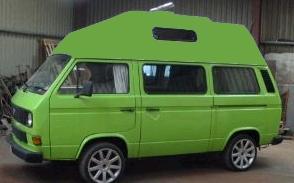
How much for shipping to Sacramento, California?
For example the last time I got a quote to Fresno California (from Toronto) it was $1600.00. It would be the same for 1 top or for 4 by the way. Seems like a lot, but the tops, from a shipper/truckers point of view are big and take up a lot of volume in the truck. I suggest, if you know someone else who is interested, that multiple tops be shipped and the cost therefore split. I've had other inquiries from folks in Ca who are interested, so, I could put them in touch with you if you want to move forward.
( I will never give out contact information without explicit permission to do so though) J.C This is a moot question now in any case. With distributors around the U.S. it is much more cost effective to either drive to the one closest to you to get a top, have it installed there if you wish, or have it shipped to you from the closest distributor. Any ground shipping will be expensive however.

Can you carry heavy objects like canoes on the high top. By the sound of it it is only glued on which does not sound very confidence inspiring (presumably it would be possible to bolt it on if you wanted to?)

How thick/sturdy is the top and how much does it weigh?
When we began we imported tops from the U,K ,that weighed 110-115 lbs. They were constructed using the chopper gun process.and were about 1/4" thick, The NAHT hightops that we now make and supply are made by the "hand laid" process which results in a lighter, stronger and tougher hightop. Our NAHT hightops now are about 3/16" thick and weigh about 85 lbs. In another page on this site I talk about the difference between chopper gunning and hand laying, The tops we make are lighter, stronger and tougher than chopper gunned tops. They also take longer to make an use more expensive materials.
Re. the bolting on - the problem with any "through fasteners" is that they go through - leading to the potential for leaking and rusting. If you were to compare the actual bonding surface area of using just the bonding adhesive as opposed to "through fasteners" - bolts or screws or rivets - I think that you would come to the conclusion that there is a great deal more surface bonding area using the adhesives, without the potential problems of leaking. Hey - whole aircraft wings are now made pretty much without through fasteners - just using carbon fibre, epoxy resins and adhesives. The top will be secure and bonded permanently to the van.
The following is copied from a discussion on this from The Samba
With respect to a high top - to prevent the forward and back movement that might be inherent with a load on top of longer supporting legs, the legs could either be attached to the top similarly to how racking is attached to a fibreglass pop top or - and I think that this would be a far better solution as it would not involve drilling holes in the high top and would be significantly stronger - be braced with short diagonal braces on each side They would support no weight but keep the rectangular shape of the racking from deforming into a trapezoid under pressure (load). It wouldn't be the load that would cause the rectangle of the racking to trapezoid, it would be Newton's first law - upon application of the brakes, the canoe on top would tend to keep on going and without bracing would exert the force of a 2 foot lever on the attachment points at the gutter. The diagonal bracing would eliminate any movement or potential for such movement and prevent the collapse of the rectangle into a trapezoid.
Any racking that is used in conjunction with a hightop should transfer the weight that it carries directly down to the van gutters. They should NOT be attached to the top by way of fasteners passing through holes in the top. Racking is not necessary for light weight items - eg solar panels etc BUT heavier objects, boats, canoes etc should be suported on racking designed so that the entire weight being supported is transferred directly to the van guttrs.
|
| |